Principality of Ardalan میرنشینی ئەردەڵان | |||||||
|---|---|---|---|---|---|---|---|
| 14th Century–1865/68 | |||||||
| Status | Vassaldom of various empires and dynasties including Qajar | ||||||
| Capital | Sanandaj | ||||||
| Common languages | Kurdish, Gorani, Sorani | ||||||
| Government | Principality | ||||||
| Wali | |||||||
• ?-? | Bani Ardalan | ||||||
• 1846–1848 1860–1867 | Amanollah Khan Ardalan (last) | ||||||
| History | |||||||
• Established | 14th Century | ||||||
• Disestablished | 1865/68 | ||||||
| |||||||
| Today part of | Kurdistan Province | ||||||

 |
Ardalan (Kurdish: میرنشینی ئەردەڵان)[1] was a hereditary Kurdish vassaldom in western Iran from around the 14th century until 1865[2] or 1868[3] with Sanandaj as capital.[4] The territory corresponded roughly to present-day Kurdistan Province of Iran and the rulers were loyal to the Qajar Empire. Baban was its main rival. Gorani was the literary language and lingua franca.[4][5] When the vassaldom fell, literary work in Gorani ceased.[6]
History
The ruling family of Ardalan belonged to the Bani Ardalan tribe, whose name may has been suggested to have been acquired from a Turkic rank. The ruling family considered themselves to be descended from Saladin (r. 1174–1193), the founder of the Ayyubid dynasty (1171–1260/1341). Other tribal folklore stories claim that they emerged during the Sasanian (244–651) or early Abbasid (750–1258) eras.[7] One source claims that the ruling family was descended from the first Sasanian monarch, Ardashir I (r. 224–242).[8] According to Sharaf al-Din Bitlisi, the renowned Kurdish historian, the earliest known leader of the tribe, Bani Ardalan, was a descendant of Nasr al-Dawla Ahmad ibn Marwan, who was the ruler of Marwanid Emirate in 1011–1061 centered in Diyar Bakr. He settled down among the Goran Kurds in Kurdistan and toward the end of the Mongol period took over the Sharazor, where he established himself as an absolute ruler.[7][8]
By 1736, Nader Shah had overthrown the Safavid dynasty and started expanding the borders of Iran both to the east and west. He fought numerous wars against the Ottoman Empire from the start of his reign until his death in June 1747. Some of the lands controlled by the Kurdish rulers were repeatedly transferred during these battles. The Ottomans and Nader Shah occupied Ardalan more than any other of those regions. In addition to these states, Ardalan was also invaded by the principalities of Mukriyan, Baban, and Shahrizor.[9]
Soon after Nader Shah's assassination, Karim Khan Zand became the new ruler of Iran. He gained control over most of the country, and before the winter of 1749, had launched a military operation against Ardalan. Its ruler, Hasan Ali, attempted to diffuse the conflict despite his lack of preparation, but failed. The Zand army destroyed his capital, Sanandaj. Kurdish rulers were never awarded important posts in the Zand dynasty's administrative hierarchy, such as the office of beglerbegi (governor-general). Hereditary positions required royal approval, and Karim Khan did not always acknowledge the rulers those who were in line to take over their inherited domains.[10]
Literature
Under Halo Khan Ardalan and his successor Khan Ahmad Khan Ardalan, the towns of Ardalan were restored. They also supported writers and poets who wrote in Arabic, Persian, and especially Gorani, a language that was far more spoken than it is now.[11]
See also
References
- ↑ "میرنشینی ئەردەڵان، بابان، سۆران لە بەڵگەنامەکانی قاجاریدا 1799–1847" (PDF) (in Kurdish). 2002. Retrieved 2 May 2020.
{{cite journal}}: Cite journal requires|journal=(help) - ↑ David Mcdowall (1996). The Kurds (PDF). Minority Rights Group International Report. p. 20. Retrieved 2 May 2020.
- ↑ Najat Abdulla-Ali (2006). Empire, frontière et tribu Le Kurdistan et le conflit de frontière turco-persan (1843–1932) (in French). p. 159.
- 1 2 Michael M. Gunter (2009). The A to Z of the Kurds. Scarecrow Press. p. 10. ISBN 9780810868182.
- ↑ Jemal Nebez (2000). "The Kurdish Language from Oral Tradition to Written Language". Archived from the original on 2004-12-21. Retrieved 4 May 2020.
- ↑ Maisel, Sebastian (2018). The Kurds: An Encyclopedia of Life, Culture, and Society. p. 166. ISBN 9781440842573.
- 1 2 Oberling 1988, pp. 693–694.
- 1 2 Frye 1960, p. 626.
- ↑ Atmaca 2021, p. 64.
- ↑ Atmaca 2021, p. 65.
- ↑ Blau 2010, p. 7.
Sources
- Atmaca, Metin (2021). "Negotiating Political Power in the Early Modern Middle East: Kurdish Emirates between the Ottoman Empire and Iranian Dynasties (Sixteenth to Nineteenth Centuries)". In Bozarslan, Hamit; Gunes, Cengiz; Yadirgi, Veli (eds.). The Cambridge History of the Kurds. Cambridge University Press. ISBN 978-1108473354.
- Blau, Joyce (2010). "Written Kurdish literature". In Kreyenbroek, Philip G.; Marzolph, Ulrich (eds.). Oral Literature of Iranian Languages Kurdish, Pashto, Balochi, Ossetic, Persian and Tajik. I.B. Tauris. pp. 1–31. ISBN 978-1845119188.
- Floor, Willem (2008). Titles and Emoluments in Safavid Iran: A Third Manual of Safavid Administration, by Mirza Naqi Nasiri. Washington, D.C.: Mage Publishers. ISBN 978-1933823232.
- Frye, R.N. (1960). "Ardalān". In Gibb, H. A. R.; Kramers, J. H.; Lévi-Provençal, E.; Schacht, J.; Lewis, B. & Pellat, Ch. (eds.). Encyclopaedia of Islam. Volume I: A–B (2nd ed.). Leiden: E. J. Brill. p. 626. OCLC 495469456.
- Matthee, Rudi (2011). Persia in Crisis: Safavid Decline and the Fall of Isfahan. I.B.Tauris. ISBN 978-0857731814.
- Matthee, Rudi (2015). "Relations between the Center and the Periphery in Safavid Iran: The Western Borderlands v. the Eastern Frontier Zone". The Historian. 77 (3): 431–463. doi:10.1111/hisn.12068. S2CID 143393018.
- Oberling, P. (1988). "Banī Ardalān". In Yarshater, Ehsan (ed.). Encyclopædia Iranica, Volume III/7: Banān–Bardesanes. London and New York: Routledge & Kegan Paul. pp. 693–694. ISBN 978-0-71009-119-2.